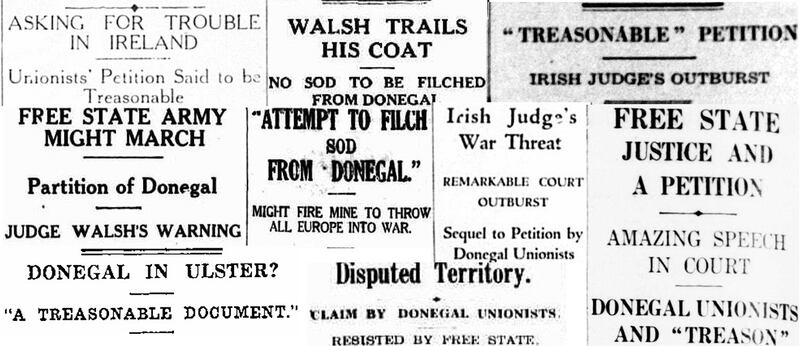The island of Ireland is filled with lesser-known histories. This year marks the centenary of the 1924–5 Irish Boundary Commission, which left some unionist and nationalist communities on the “wrong” side of the Border.
It is also, however, the 90th anniversary of a lesser-known event, the East Donegal border petition. In November 1934, in East Donegal, 7,368 Protestants signed a petition calling unsuccessfully for their region to be incorporated into Northern Ireland.
The East Donegal petition came after Fianna Fáil won the 1932 general election, leading to the abolishment of the oath of allegiance, the right of appeal to the privy council and prerogatives of the governor-general – a weakening of the Free State’s ties with London.
[ Kemi Badenoch elected new leader of UK ToriesOpens in new window ]
The most important change for southern loyalists was the Irish and Nationality Citizenship Bill, which created a new definition of Free State citizenship and was viewed by many unionists as trying to deprive Free State citizens of their rights as British subjects.
READ MORE
The Statute of Westminster 1931 made these changes legal. To exacerbate matters, an Anglo-Irish trade war between 1932 and 1938 – better known as the “economic war” – depressed agricultural prices.

Its impact was especially felt in the Border counties that relied most on cross-Border trade.
In fact, most of the original petition instigators were farmers who used their influence to rally East Donegal’s Protestants through the Orange Order and elements of the Donegal Protestant Association.
Planning began in July 1934, with experienced members who had organised and collected signatures from the Ulster Covenant in 1912, and they sought help, too, from the Irish loyalist Imperial Federation and the Ulster Unionist Party.
[ It is dangerous to compare the slave trade and British rule in IrelandOpens in new window ]
Reporting often reflected newspapers’ political leanings. The unionist Belfast Newsletter put the number of signatories at 8,000, The Irish Times put it at 8,500, while the nationalist Derry Journal cited 5,000. The Irish edition of the Daily Express claimed 10,000.
How did the Irish Government handle such a petition? An Garda Síochána investigated suspected instigators, including independent Protestant councillors on Donegal County Council and a TD, Major James Myles, though he was not involved.
Letterkenny District Justice Louis Walsh called the petition “treasonous”, saying it could threaten war in Ireland that could in turn throw the rest of Europe into conflict. Instead of quelling the petition, Walsh’s threats created an international furore.
Newspapers across the British Empire condemned Walsh, with The Australian Daily Telegraph running the headline ‘WALSH TRAILS HIS COAT’; the Southern Rhodesian (Zimbabwe) Bulawayo Chronicle headline was ‘ASKING FOR TROUBLE IN IRELAND’; while the South African Cape Argus featured ‘OUTBURST BY A JUDGE’.
Even though the petition went nowhere, the anger was eventually directed elsewhere. From 1934 to 1938, Donegal milk farmers protested the Northern Ireland Milk Act, which restricted dairy products from outside the UK coming into Northern Ireland.
In response, Donegal farmers still entered their traditional markets in Derry and Strabane, regardless of potential fines or arrest. The Royal Ulster Constabulary did not interfere, apart from issuing warnings.
[ Big tax and spending hikes, but little growth from the UK budgetOpens in new window ]
Vendors from the Free State selling in Derry and Strabane were told they were liable to prosecution for operating without a licence. Despite the warnings, the Donegal farmers kept going over the Border in an affair known locally as the “Derry-Donegal milk war”.
Though the petition for repartition ultimately failed, it offers a number of insights in the debate over a united Ireland. If partition were to end, this would certainly concern many Northern unionists as their representatives would be a minority within the Oireachtas.
If there were no compromises for unionists in a united Ireland, such as a federal system to retain a devolved Northern Ireland, this could cause an economic crisis that might be a catalyst for unionist discontentment.
In the event of a united Ireland, and this is an issue that has not been considered much to date, if at all, trade with Great Britain will have to continue unhindered. How could it not? What impact would that have on Irish membership of the European Union?
Efforts a century ago to replace trade losses did not work. Then, the Free State set up alcohol factories in Carndonagh and Manorcunningham to encourage farmers to grow potatoes, and a bacon-curing factory in Letterkenny.
They started in 1937 and 1940, but did not compensate for the milk trade losses. In such a situation, it would not be hard to fathom that Northern unionists could end up disgruntled, or fear that scenario, as their Donegal brethren then were.
The only difference will be the approach of the Irish Government, due to learning from the past and to fear of the backlash from the modern media, along with endangering the Northern Irish peace process.
Overall, even though the East Donegal petition was nearly a century ago, it is a valuable reminder that not everyone embraces change. It is the responsibility of those in power to ensure that nobody is forgotten in the process of unification.
For unification to happen, those who argue for it must look to unite “Orange” and “Green” to ensure that a united Ireland – if that is to happen in the decades ahead – can succeed in finding the peaceful compromises necessary to bring everyone together.
Samuel Beckton has been assisted by the Arins Project, a joint initiative of the University of Notre Dame’s Keough Naughton Institute for Irish Studies and the Royal Irish Academy (https://www.ria.ie/research-programmes/arins/). He is the author of “The East Donegal Border Petition and the Derry–Donegal Milk War”, 1934-8 (Dublin: Four Courts Press, 2023).














